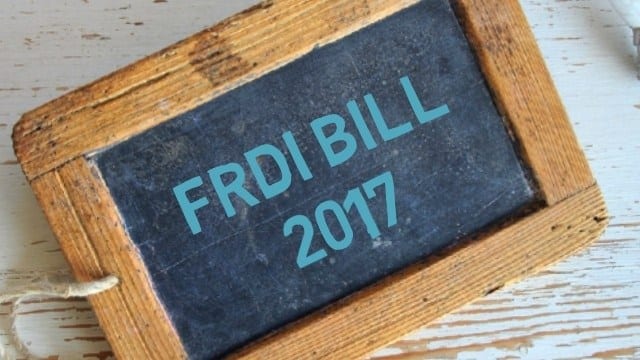Economy
Story of FRDI Bill

In July 2018, Government of India decided to withdraw the proposed ‘Financial Resolution and Deposit Insurance (FRDI) Bill’ under heavy flake from opposition, investors and economists.
What is the need for FRDI Bill?
Failure of Financial systems is an ever-present threat, especially in developing economies like India. Example of such a failure can be a bank failure, in which the bank becomes insolvent or is unable to pay the money owed by it to the depositors. Since the banks handle consumer funds, any such event could lead to a disastrous situation for financial stability of the country and could result in heavy losses for the depositors.
The current solution for any such crisis is provided under various laws which are enforced by different regulators (RBI, SEBI, etc.), government (Central, state) and judicial courts. This causes the resolution of the crisis to stretch for long periods of time while the authorities deliberate over their role and the limit of their powers.
The division of powers is apparent when we consider that in case of a bank failure:
- RBI can only shut down the bank or merge it with a stable bank. Its powers are limited to changing management of the bank, imposing moratorium in some cases and recommending mandatory mergers.
- The Central Government is empowered to restructure public sector banks, and regional rural banks but not the private owned banks.
- High Courts can liquidate non-banking financial companies.
The Insolvency and Bankruptcy Code, 2016 is a milestone in the history of financial policy of India but is limited in its ambit to only non-financial firms. Question arises what will happen in case of a failure of private sector financial firms? In every instance of such crisis there is a confusion regarding the correct process and the roles of different financial authorities. Here, the FRDI Bill was supposed to come into play.
What is FRDI Bill?
The FRDI Bill proposed to setup a Resolution Corporation (RC) for timely and orderly resolution of a failing financial firm. The Bill introduced a five-stage health classification of financial firms and the responsibility of the Resolution Corporation was to step in at appropriate time when a firm is classified in the category of material risk to viability. This intervention would come much before the ailing firm can be classified in the category of critical risk to viability when there would be no option available but to resolve or liquidate the financial firm.
The FRDI Bill included provisions to transfer the deposit insurance functions from the Deposit Insurance and Credit Guarantee Corporation (DICGC) to the RC, to protect the depositors. (How this ensures better protection of depositors we will see in the due course.)
FRDI Bill introduced a variety of resolution tools which could have been used to resolve any such crises, these include: transfer assets and liabilities of a financial firm to another, acquisition, merger, bridge service provider, bail-in clause, etc.
Such guidelines and tools are currently not available in the country to a single body devoted to the cause, nor is any institution empowered enough to investigate such cases and act independently to resolve them. Many other countries in the world however, have already established similar institutions.
“Problems” with FRDI Bill
Various newspapers, politicians, and economists have pointed flaws in the FRDI Bill. Sometimes their claims are unfounded and sometimes outrageously uninformed; however we will take a look into their claims and try to provide an explanation for their reaction to the Bill and why their doubts were misplaced.
- Deposits will be at risk.
It has been claimed that under the FRDI regime the deposits in financial institutions would be at risk. For example: they would not be protected in case of a bank failure. This is only half truth.
The truth is that at present under the DICGC Act, only the deposits up to ₹1 lakh are insured. The rest of the amount deposited is already facing the risk. In the FRDI regime, the RC would have been empowered to increase this limit after consultation with the RBI. It certainly could not decrease the limit and since the limit was decided in 1990s, considering the inflation we can guess that the new limit could lie anywhere between ₹5 lakh to ₹10 lakh.
Let’s understand this with an example: Suppose the RC increases the deposit insurance limit to ₹5 lakh (realistic assumption) and you have a ₹10 lakh deposit in the bank. Then, in case of bank collapse, ₹5 lakh of your deposit would be protected and the rest ₹5 lakh would be converted into a long term deposit. In the current situation only ₹1 lakh of your deposit would be protected and the rest ₹9 lakh is forfeited.
- RC can use the depositors’ funds to ‘Bail-in’ to resolve an ailing firm.
This statement is correct in essence but is twisted in media reporting. This fact has been reported as if the government can cancel the liabilities owed by the bank to the depositors to bring it out of a crisis. In this projected event the depositors will lose all their money. However, the FRDI Bill contained certain provisions that safeguard the depositors’ interests.
The safeguards built in FRDI Bill were:
- In case of a bail-in, the insured deposits of banks cannot be used – Section 52(7).
- The RC was empowered to design an appropriate bail-in instrument. This would be subject to Government scrutiny and Parliamentary oversight which will ensure that the interests of the public are not sacrificed for the resolution of the firm.
- Prior consent of the depositor would have been required for cancellation of the liabilities beyond insured amount – Section 55(2).
This means that in our above example in the case of bank failure if ₹5 lakh of your money was already insured, and the rest ₹5 lakh will only be waived off as the bank’s liability if you give your consent. Previously, under the Banking Regulation Act, 1949, in case of the forced mergers of banks, the rights of depositors of a merging bank can be reduced and have been reduced, without the consent of depositors.
- Bail-in power can be used in a judicious and reasonable manner only by the RC. And in this case, the burden to ensure that all creditors, including uninsured depositors, get at least such value, which they would have received in the event of liquidation of a bank, falls upon the RC. If the depositors feel that RC has exercised its bail-in power injudiciously and unreasonably, for example, if the depositors of a bank get less value than in liquidation, than such they will have the right to get compensation from the RC on an order of the National Company Law Tribunal.
- Bail-in would save government’s funds at the cost of depositors’ money.
The bail-in is opposite of bail-out in which the government uses its own funds i.e. taxpayer’s money, this much is correct. However, under the FRDI regime, the claims of uninsured depositors would be given priority over the claims of unsecured creditors and government dues. Thus, this claim was also unfounded.
Why the Bill was dropped?
Even though we have established that most/all claims about the Bill being against the interests of the interests were unfounded, still it was dropped by the government. Various people negatively criticised the FRDI Bill, mostly made up of opposition parties, depositors and economists.
Depositor’s opposition to the Bill can be explained as them being not knowledgeable about the legal and financial terms, language of the Bill being too complicated, or they just might be influenced by the incorrect interpretation of the Bill in the social media. Some eminent economists have also published their views against the Bill. By their arguments, it is evident that they are uninformed about Section 52(7) and Section 55(2) of the FRDI Bill. Now, this might be acceptable for depositors who are not in this trade but for an economist complete understanding of such provisions is required to provide constructive criticism rather than uninformed jargon.
Correctly informed of not, the opposition was heavy and this forced the Government to drop the Bill.
What could have been done?
- The Bill could have included a minimum limit for insured deposit that is greater than the current ₹1 lakh.
- The provisions relating to Section 55(2), Section 52(7) (explained above) and the Bail-in clause could also have been popularised and made available to public (and “economists”) in an easier language.
Conclusion
The way forward in financial stability is paved with steps like GST, IBC and FRDI Bill. It is only by taking informed decision (which sometimes may be anti-populist) that a government achieves good governance. However, the risk is always there that good governance will cause the government to not come back in power after 5 years.
Just like with demonetisation and GST, it is also possible with FRDI Bill, that it comes back in another regime and the current government will be the one criticising it then. In any case, at present the FRDI Bill is out of picture.

































